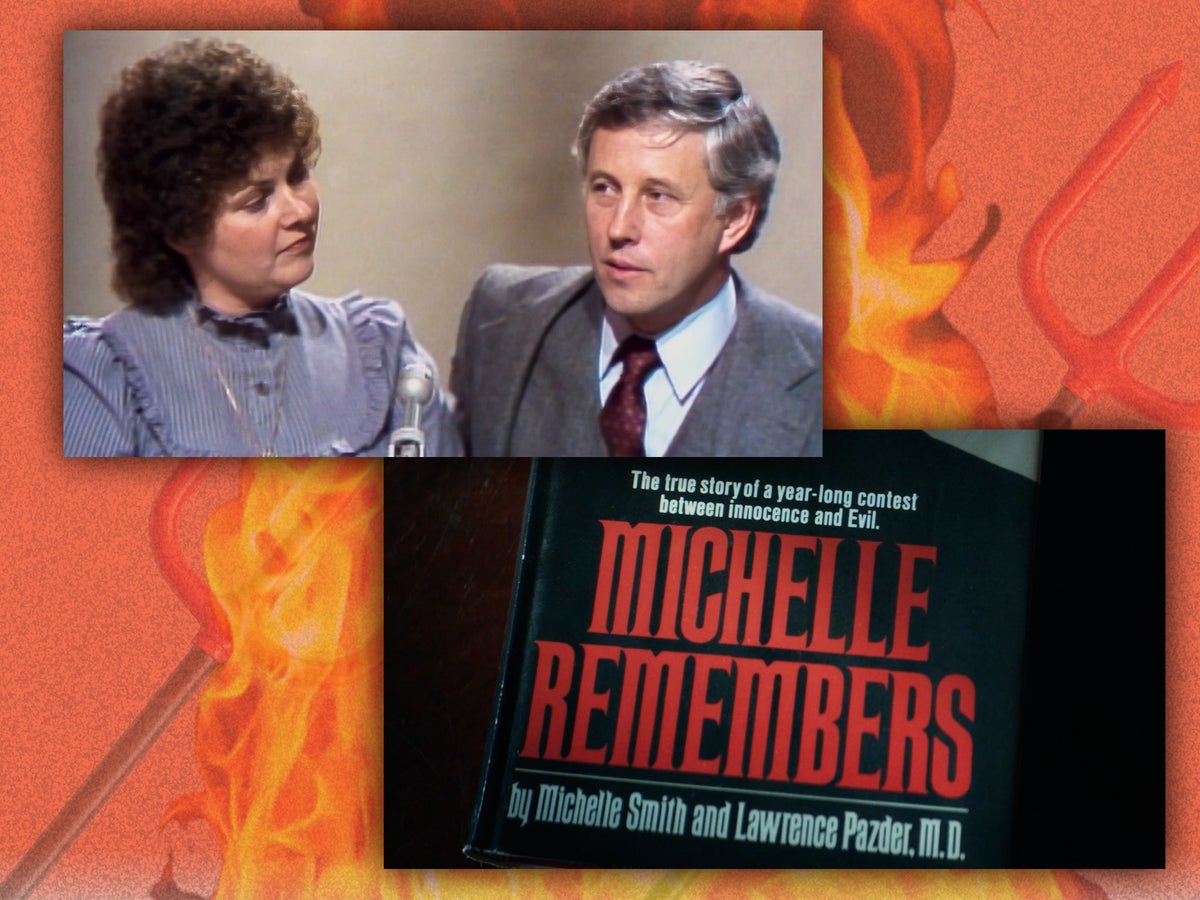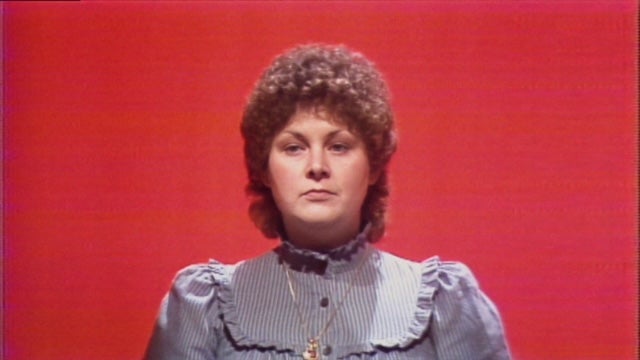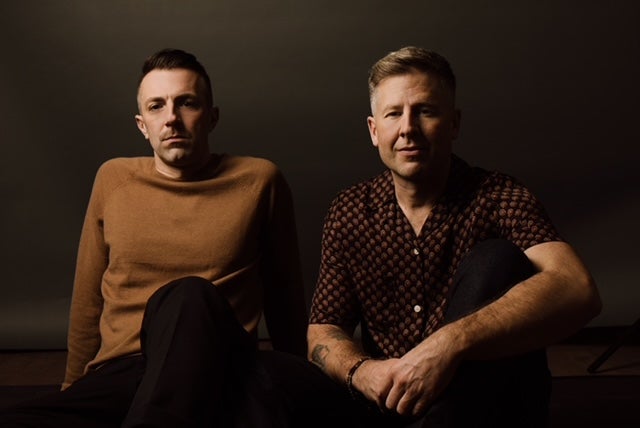
For a time, they were everywhere – a Canadian psychiatrist and his soft-spoken patient, unassuming harbingers of doom at the hands of the devil. Larry Pazder and Michelle Smith exploded onto talk shows and into headlines after the 1980 publication of the co-written memoir Michelle Remembers, detailing the patient’s “recovered” recollections through therapy about childhood torture inflicted by a Satanic cult.
“Basically, what I remember was a 14-month period of my life at age five where I was given to a group of people whom at first I wasn’t aware of what they were doing, other than, to a child, they were adults doing things that I couldn’t understand and that frightened me,” Ms Smith said in one television interview. “They sacrificed animals and they used fetuses of babies in their ceremonies,” she told a different outlet.
And she warned — perhaps most distressingly — in yet another TV interview: “I think, today, it’s very, very wise to take a good hard look at where you place your children ... into whose care you place your child.”
What followed on the heels of the book and the media tour was a hellish hysteria that spread across the world. Stories of recovered memories and vile abuse abounded, many striking eerily similar chords; there was talk of abduction, sacrifice, sexual abuse and, mind-bogglingly, even the use of “baby wax” made from murdered infants.
Arguably most infamous were the 1983 McMartin preschool accusations in California, in which bizarre allegations of physical and sexual abuse — along with witchcraft and supernatural abilities — were levelled against the family operating the facility. Ms Smith and Dr Padzer consulted on the case.
The McMartin charges were eventually dismissed, and the Canadian authors of Michelle Remembers faded into the background along with the worldwide Beelzebub brouhaha.

But there was far more to the story — and a trail of broken lives left in the memoir’s wake.
“There’s hundreds of articles where Michelle and Larry, they’re on TV, they’re on radio telling their side of the story; not a single person spoke to the family,” says filmmaker Sean Horlor, whose new film Satan Wants You premieres on Saturday at the South by Southwest (SXSW) festival in Texas. “Never before had they shared their side of the story ... for the very first time, you hear from Larry’s ex-wife, his daughter and Michelle’s sister actually saying, ‘Wait a minute — this is what really happened.”
As the psychiatrist’s ex, Marylyn, and daughter, Theresa, tell it, Ms Smith was a constant presence in their lives even before the book, ringing at all hours and even following the family on trips.
Within a few short years of the book’s publication, the Padzers divorced — and he went on to marry his former patient.
Horlor, the director of the film, actually grew up in Victoria, the same city where Ms Smith and her new husband resided; they lived “10 minutes down the road from us in a big house by the ocean,” he tells The Independent. His aunt even trained as a nurse under Dr Padzer.
“Everyone talked about this in Victoria ... it wasn’t until we started making the film, though, that I knew that it had blown up and that they had a role in this [global panic,]” Mr Horlor says. “I had no idea that their book affected millions and millions of people around the world.”
Then he actually read it.
“The book is shocking — truly,” he says. “It is a horror story. It is a religious horror story — the Pope’s involved, they go to the Vatican. It’s based on this like two years of daily therapy, where she is just reliving these childhood memories on Larry’s couch, and they’re recording it.
“And it’s not just like bad childhood memories — it’s like, you know, ‘My parents are members of a Satanic cult; they sacrifice animals, they murder a woman, they give Michelle away to the devil in a graveyard ... this is the research starting point.”
Michelle, then married to a man named Doug Smith, had been treated for several years by Dr Padzer before miscarrying in 1976; she called him for further help after having particularly vivid and terrifying dreams. Around the same time, his wife recalls in Satan Wants You that she and Dr Padzer had seen the TV movie Sybil, chronicling a young woman suffering extreme abuse at the hands of her mother.
“Before he started on his book, I was at home, and I was sitting there watching that show Sybil ... he said, ‘I want to do the same thing,” his wife, Marylyn, says in the documentary. “He said, ‘I don’t want to be just an ordinary psychic; I want to be famous — and he said, ‘I’ve got a patient just like that’, and that’s when he phoned her.”
“And it just took off from there.”
As he treated Michelle under hypnosis — lying with her on the therapy couch and eventually on a mat on the floor — the psychiatrist recorded her fragmented “memories” of horrific torture. He gave her the family’s home phone number and she began ringing incessantly; Marylyn and Theresa recall how Michelle either hounded or followed them to family events and vacations.
But “he did believe her,” Marylyn says in the film. “There’s no two ways about it. He believed everything.”
Dr Padzer was having the recordings transcribed and, a devout Catholic, involved the local parish priest in the story, then the bishop, who travelled with the psychiatrist and Michelle to Rome to tell her hellish tale to the Pope.
His wife, concerned at how much Michelle and preparations for the book were consuming her husband’s life, at one point even reached out to the local priest, using her husband’s equipment to record the call. When she pressed him for when the book would be published and why it was so important, the film details how he claimed people would be shocked and there would be an “explosion.”
He was right, and their celebrity took off; time and time again, on screens and in papers across the world, they recounted galling details of the “abuse”. Tabloids branded her the “Bride of Satan”.

Michelle’s family, back in Victoria, were flabbergasted; her mother had passed away years earlier, but the patient’s estranged father tersely denied the allegations to reporters at the time with horror.
“I don’t believe that my mom was that type of person that would turn her child over to a Satanic cult; it was not part of my childhood,” Michelle’s sister, Charyl, says in the film, clearly still staggered by the claims.
She adds: “In the book, Michelle says that my mother was this horrible person ... but I don’t understand why Michelle would even think that. What is wrong with her?”
She points out that her mother’s remains are interred at a church, and that her late parent had used faith to help cushion life with a volatile and alcoholic husband.
But claims like Michelle’s were taking off exponentially, and they were becoming more and more fantastic. Other women started coming forward, telling tales of birthing babies they were forced to murder; the topic was discussed publicly everywhere from CNN to Oprah during the 1980s. Cases were investigated and prosecuted based on wild allegations with little or no evidence, some people serving years in prison or under public scrutiny before vindication.
Dr Padzer – who died in 2004 – and Michelle began doing the speaking circuit as he became viewed as an expert in ritual satanic abuse; all of a sudden, therapists seemed to be treating adult and juvenile survivors of Satanists everywhere all of the time.
“I’m a cynical person,” FBI agent Ken Lanning says in the film, describing himself as then “the bureau’s expert on Satanism, the occult, cults ... the whole package”.
“I spent 30 years in law enforcement; I assume that people are lying unless I know otherwise,” he says. “But a lot of therapists have the opposite bias. They assume that everybody’s telling the truth unless they know otherwise, and actually, this becomes a huge aspect to these allegations of Satanic ritual abuse, particularly what’s called the adult survivors, and that’s what Michelle would be. The things in the adult survivor cases, it was even more weird than it was in the younger kids at daycare centers.”
He describes attending a conference in Virginia around 1987 in which Dr Padzer was a featured speaker while Michelle sat to the side.
“Dr Padzer indicated that he thought most of the college cases were a bunch of nonsense, but then he said something that I was tremendously interested in: ‘I’m going to tell you how to identify the real cases,’” Mr Lanning says in the documentary. “So I said, man, this could be really valuable information, because I was never one of those people that believed they were all true or they were all false. There can be a middle ground in here.
“He would start to describe these rituals and began to talk about Michelle, but cops tend to ask a lot of questions, so the cops in the audience began to raise their hands ... and I just kind of began to notice that, every time somebody asked a question, Michelle never said a whole lot, and he would always answer the question.

“After a while, after this happened half a dozen times, I just raised my hand,” Mr Lanning says. “I said, ‘I’m curious — when people ask, this all happened to Michelle; how come she doesn’t give the answer, she turns to you?’ He just said some version of — I don’t remember his exact words — something like, ‘Well, when she first came to me, she had no conscious memory of it, and then through this therapy, this story began to come out over a year or more’s time’ and then he recorded it, wrote it all down and documented it, and then ... most of it left her memory. And he was not the keeper of the story.
“I decided that that greatly reduced the value of what he was telling me, so I put my pen down and didn’t take as many notes after that.”
The lunch break provided another jolt to the FBI expert.
“Somehow, it just came out — he didn’t try to hide it — but it came out that Michelle was now his wife,” Mr Lanning says. “And that was another factor that kind of caused me to think, well, that’s kind of an inappropriate kind of doctor/patient kind of a thing. How did that affect this story that he’s now telling?”
Both the psychiatrist and Michelle had, in fact, divorced their spouses and married each other. Michelle’s husband was blindsided and the split was awful, her sister says in the film; a devastated Marylyn had actually filed for divorce, fed up by the entire situation and, particularly, a magazine photo of Dr Padzer “treating” Michelle in just her bra.
Many who knew the doctor and patient personally were taken aback by their marriage, though some — such as friend Cheetie, one of the typists transcribing Dr Padzer’s recordings — had picked up on romantic feelings on Michelle’s part.
“I think Michelle loved Larry; she worshipped him,” Cheetie says in the film. “She worshipped him, but him and Michelle were exact opposites, and I can’t figure out why Larry married her. I really can’t ... Would it come from needing to protect her? I know he felt a need to protect her and look after her, but marrying her is a whole different ballgame.”
As the Nineties began and progressed, Satanic Panic was fading, therapists who’d “recovered” memories and treated alleged victims were facing lawsuits, and Dr Padzer and Michelle were living their wedded existence in Victoria before he passed away in 2004 at the age of 67.
The psychiatrist’s ex-wife, meanwhile, had been horrified to learn that people had been put behind bars in a hysteria stoked by her former spouse — and had dedicated herself to debunking the entire memoir. She conducted interviews and found evidence that Michelle had been in school, for example, at times when she’d claimed the abuse by Satanists was occurring.
“She was saving everything that had to do with this,” Satan Wants You co-director Steve J Adams says of Marylyn. “She was collecting news articles. She was collecting evidence to show that it didn’t happen.”
When the filmmakers reached out to her, she “just started talking”.

For Marylyn and her daughter, the filmmakers believe and hope the documentary provided “a little bit of catharsis, actually, getting it out.
“You could just really tell that this really affected her life and it was lifelong; it wasn’t something that has disappeared -- and talking to her about it, all the memories came back right away.”
Michelle herself declined to be involved in the project, they said, though they feel her decision “was a huge motivation for Cheetie to actually participate and say, ‘You know what? I know you are going to talk to all sorts of people, and I want to make sure that Michelle’s point of view is represented in your film, and I’m here to speak for Michelle.’”
The patient’s sister Charyl, however, says she believes Michelle “is living in hell, because the story has haunted my family for years. We pretend that we’re a family, but there’s always a feeling of: How could you do the damage that you did by telling this story that wasn’t true?”
But the directors noticed other pervasive feelings among the film participants: fear and dread that the world has learned nothing from the near-laughable Satanic panic decades ago.
“General consensus ...is, ‘Oh no, here we go again,” they tell The Independent, referring to QAnon and proliferating conspiracy theories like Pizzagate. “And it’s like, 40 years on from Michelle Remembers and the Satanic Panic, and yet here we are, in the present day with the same rumors happening, the same people using satanic conspiracies to accuse people of crimes they never committed – gunmen showing up at places to shoot people.”
“There’s a huge motivation, not just to tell this interesting story from the past, but it is relevant. It’s happened before –happened recently. I guarantee you it will happen again.”







